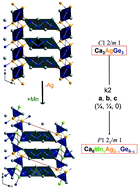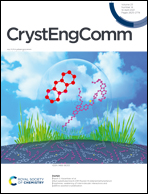Uncovering new transition metal Zintl phases by cation substitution: the crystal chemistry of Ca3CuGe3 and Ca2+nMnxAg2−x+zGe2+n−z (n = 3, 4)†‡
Abstract
High-temperature solid-state reactions of the respective elements afforded the new transition metal Zintl phases Ca3CuGe3 (Sc3NiSi3 type, monoclinic C2/m – i7, Pearson code mC28), Ca6MnxAg2−x+zGe6−z (own type, monoclinic P21/m – e14, Pearson code mP28) and, Ca5MnxAg2−x+zGe5−z (Ca5MgAgGe5 type, orthorhombic Pnma – c12, Pearson code oP48) as evidenced by single-crystal X-ray diffraction. They are additional representatives of the recently discovered homologous series Ca2+nM2+zGe2+n−z, already reported with M = Ag, Mg. These new phases were rationally prepared, after speculation that Cu and Mn could replace the isovalent Ag and Mg, respectively, to yield isostructural phases. Their crystal chemistry is discussed using established ‘structure directing rules’. Their structures are best described according to the Zintl–Klemm formalism as (Ca2+)(2+n)[M2+zGe2+n−z)]2(2+n)− featuring (poly-)germanide oligomers, [Gen](2n+2)− with n = 1–5. These Zintl anions interact with the highly polarizing small M (Cu, Ag, Mn) cations through their terminal Ge atoms, while the central Ge atoms are in trigonal prismatic coordination with the active metal Ca. Electronic structure calculations using density functional theory (DFT) were conducted on the idealized fully ordered model of “Ca3MGe3” (Sc3NiSi3 type) with M = Cu, Ag for an analysis of the chemical bonding and structure stabilizing factors. Our findings suggest that new transition metal Zintl phases can be obtained through partial to complete replacement of the highly polarizing small s-block cations (Li, Mg) in the Ca–(Li,Mg)–(Ge,Si) system by their isovalent transition metals like Ag, Cu, and Mn. However, due to differences in coordination requirements and possible strong metal–metal bonding between the d-block elements, the resulting transition metal phases may not be isostructural with their Li and Mg counterparts, even when featuring the same type of Zintl anions.

- This article is part of the themed collection: Crystal Engineering Techniques


 Please wait while we load your content...
Please wait while we load your content...